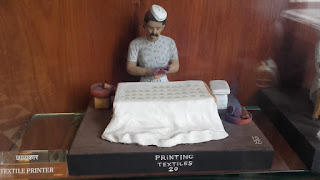I must clearly be passing well as a local since bus conductors have taken to talking to me in Marathi. Luckily "dahaa" is close enough to "dus", and "pudheel" (next) is familiar since it is in every audio announcement, but I don't think I can handle anything more complex just yet.
-
Mumbai has many museums - for example, museums for RBI, BEST, CST, Churchgate, Gandhi - but the oldest among them is the Dr Bhau Daji Lad Museum in Byculla. It shares a complex with a zoo, which is definitely a bigger draw!
One superb thing this museum does is to hold free (no prior registration either) hour-long tours every Saturday and Sunday, in English as well as Hindi and Marathi. They are conducted by trained volunteers.
Our particular guide was a doctor in training and had admirably committed to using his position to urge his listeners to be observant, historically literate, but most importantly empathetic, in these divided times.
The museum was built in 1862, then known as the Victoria and Albert museum. It was renovated in 2003 by INTACH. (More history here.) The guide pointed out the gentle green used to colour the inside walls, which contrasts well with the bronze and silver exhibits. There are ornate metal decorations everywhere, some painted in near-pure gold paint.
In the centre there is a regal statue of Prince Albert, flanked by the Muses of Science and Art. Accordingly, the exhibits on either side are broadly categorised into practical/technological ones and art/ornamental ones.
We didn't spend much time on the ground floor; it has more 'typical' museum exhibits: weapons and miscellaneous items from various centuries and parts of India. The guide picked up a couple of things to talk about in depth, rather than a speedy and superficial tour of the whole place, but he went on several tangents along the way! (About gender, communalism and so on. His intentions were undoubtedly good - what is the use of history if not to prevent us making the same mistakes? But I personally would have preferred he instead fill that time with lesser-known facts about the museum or its contents.)
More fascinating for its local flavour was the first floor. It had figurines of the various communities that came to occupy Bombay along various points in its history; also of Indian communities in general. There were maps of Bombay through the ages. It also showcased Indian rural life, from its fields to its professions to its children's traditional games.
The museum also has film screenings, exhibitions and talks round the year - will surely catch one of those sometime!
-
Mumbai has many museums - for example, museums for RBI, BEST, CST, Churchgate, Gandhi - but the oldest among them is the Dr Bhau Daji Lad Museum in Byculla. It shares a complex with a zoo, which is definitely a bigger draw!
One superb thing this museum does is to hold free (no prior registration either) hour-long tours every Saturday and Sunday, in English as well as Hindi and Marathi. They are conducted by trained volunteers.
Our particular guide was a doctor in training and had admirably committed to using his position to urge his listeners to be observant, historically literate, but most importantly empathetic, in these divided times.
The museum was built in 1862, then known as the Victoria and Albert museum. It was renovated in 2003 by INTACH. (More history here.) The guide pointed out the gentle green used to colour the inside walls, which contrasts well with the bronze and silver exhibits. There are ornate metal decorations everywhere, some painted in near-pure gold paint.
In the centre there is a regal statue of Prince Albert, flanked by the Muses of Science and Art. Accordingly, the exhibits on either side are broadly categorised into practical/technological ones and art/ornamental ones.
We didn't spend much time on the ground floor; it has more 'typical' museum exhibits: weapons and miscellaneous items from various centuries and parts of India. The guide picked up a couple of things to talk about in depth, rather than a speedy and superficial tour of the whole place, but he went on several tangents along the way! (About gender, communalism and so on. His intentions were undoubtedly good - what is the use of history if not to prevent us making the same mistakes? But I personally would have preferred he instead fill that time with lesser-known facts about the museum or its contents.)
More fascinating for its local flavour was the first floor. It had figurines of the various communities that came to occupy Bombay along various points in its history; also of Indian communities in general. There were maps of Bombay through the ages. It also showcased Indian rural life, from its fields to its professions to its children's traditional games.
Don't miss his belly.
This is a legitimate profession.
Amma and Appa: Please dress like this sometime.
The museum also has film screenings, exhibitions and talks round the year - will surely catch one of those sometime!













Nice and funny.. I liked the last line a lot😂😂😂
ReplyDeleteSigh! I have never been to this museum. This is not the museum near Regal right?
ReplyDeleteNice write-up, thanks for sharing!
ReplyDeleteEnjoyed reading. Good work
ReplyDelete